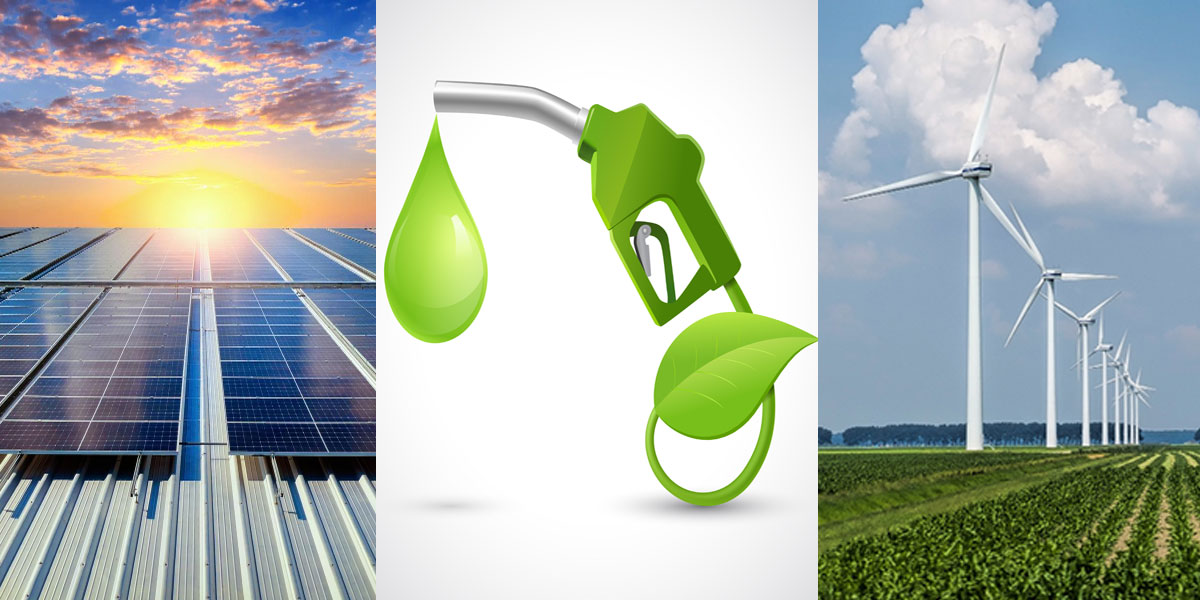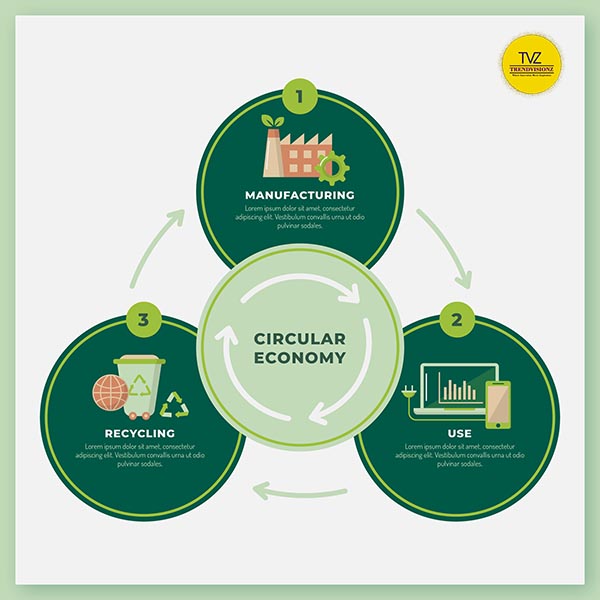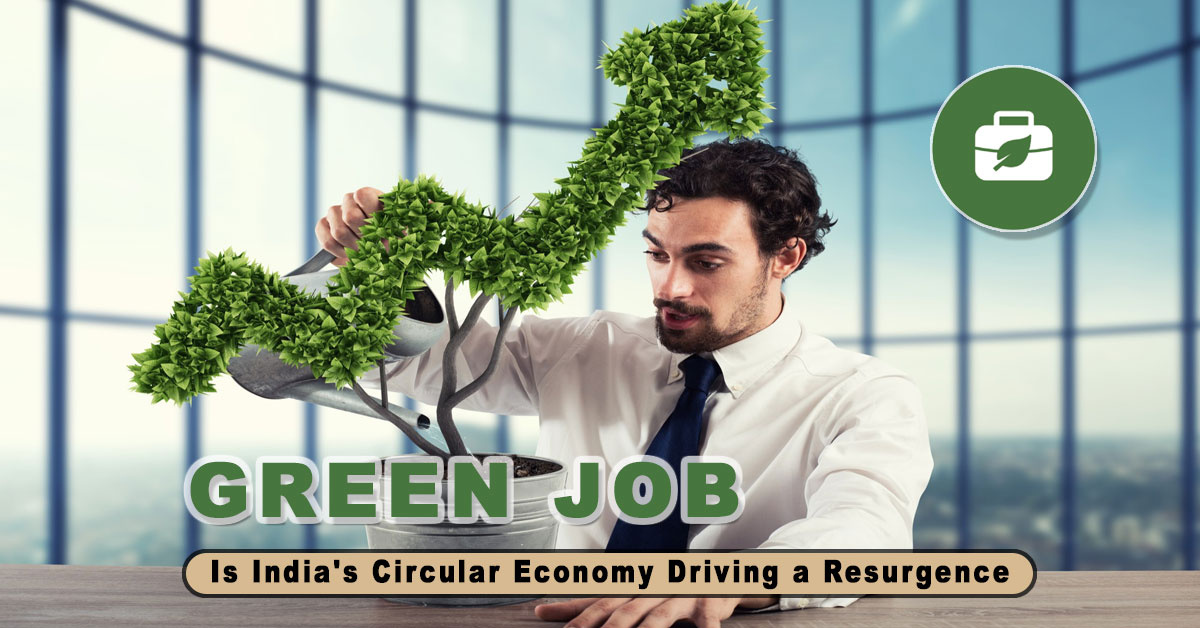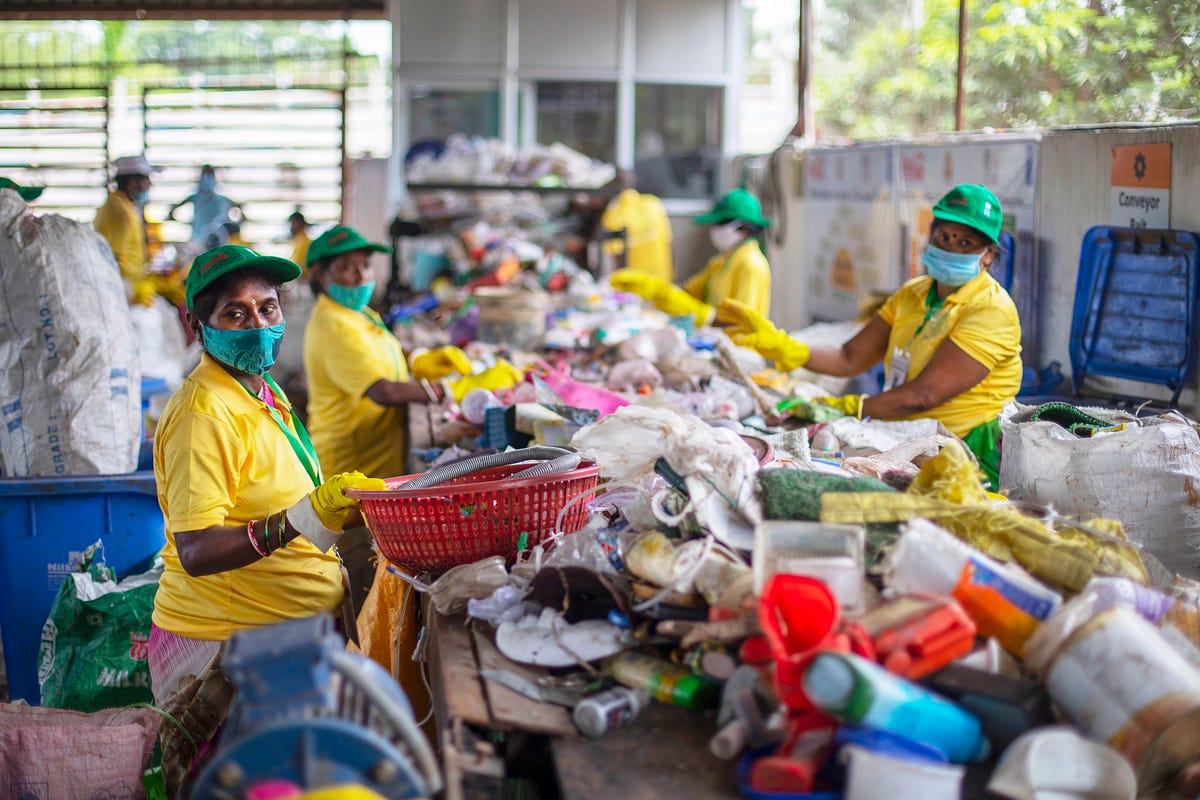The green economy isn’t just the future; it’s unfolding prominently in India. The government’s commitment to Circular Economy and Sustainability is propelling job growth and economic opportunities. New research shows green jobs in India are set to skyrocket over the next few years. An estimated 3.7 million new positions by 2025. How’s that for career inspiration?
Also Read:
SDG‘s Role in Advancing India’s Future: Circular Economy and Sustainability
The opportunities for doing so have expanded with the advent
World Economic Forum
of Fourth Industrial Revolution technology – an ecosystem that holds a dizzying
amount of innovation across digital, physical and biological spheres.
What is Extended Producer Responsibility
Advantages of Extended Producer Responsibility (EPR)
Disadvantages of Extended Producer Responsibility (EPR)
What is Circular Economy: Sustainable Resource Loop
Key Principles of Circular Economy
Circular economy is an economic system that is regenerative by design. … The linear economy is the prevailing model because simply the world is just not in tune or necessarily aware of the circular model and it’s economic and societal benefits.
Attila Turos, Lead: Future of Production, World Economic Forum
India’s Economic Potential: The Imperative of Circular Economy for Businesses
Also Read : India’s EV Evolution: Seize the Moment with Profitable Business Models
India’s Push for a Circular Economy
Waste Management
Recycling
Renewable Energy
Circular Business Models
From Waste to Wealth: How India’s Circular Economy Is Creating Opportunity
Fostering Economic Growth through Circular Economy
Promoting Circularity through EPR: A Sustainable Paradigm
Government Policies Driving the Green Transition
Swachh Bharat Mission
Unlocking Green Careers: Embracing Sustainability in the Workplace
Also Read:
- Empowering India’s Digital Realm: Are You Cyber Vigilant?
- Why Are Hybrid Cars Becoming More Popular in India?
- Electric Vehicle Charging Stations: Charging the Future
India’s Circular Economy Initiatives: Transformative Practices Across Sectors
India is making remarkable strides in embracing circular economy principles. These are evident in diverse circular economy sectors, for example, in India.
- Construction. Incorporating plastic waste into road construction materials reduces landfill usage, fostering durability.
- Waste Management. Waste-to-energy plants convert municipal solid waste into electricity. Curbing reliance on fossil fuels and reducing emissions.
- Agriculture. Utilizing crop residues for bioenergy production enhances resource efficiency and improves soil health.
- Textiles: Extended producer responsibility (EPR) guidelines encourage sustainable textile practices. Reducing waste and promoting recycling.
- Electronics: Take-back programs for electronic waste. Ensure proper disposal resource recovery and prevent environmental contamination.
A circular economy provides a sustainable approach to resource management. In this system, plastics continuously circulate in a closed loop, eliminating the traditional linear use-and-discard model. These circular economy principles initiatives underscore India’s commitment. Propelling sustainable development and environmental preservation through circular economy.
India Bets Big on Renewables: Millions of New Green Jobs Work
What are Green Jobs? According to the U.S. Bureau of Labor Statistics, green jobs encompass roles in businesses. That either produce goods and services benefiting the environment or conserve natural resources. These jobs involves aiming to make their establishment’s production processes more environmentally friendly. And reduce raw resource consumption.
As per a study report, India’s green economy will introduce 3.7M jobs, in the renewable energy sector alone by 2030. In 2017, this sector contributed 47,000 new jobs. Employing 432,000 individuals, as reported by IndiaSpend in July 2018.
Prospects for Green Jobs in India: A Growing Landscape
India is making significant strides in renewable energy. Paving the way for millions of new green jobs. On an ambitious targets, including 175 GW of renewable capacity by 2022. The nation is embracing solar, wind, and hydroelectric projects.

This commitment not only addresses environmental concerns but also generates substantial employment opportunities. The renewable energy sector, marked by innovation, is poised for sustainable growth. Very soon, it will become a cornerstone of India’s economic landscape. Thus fostering a greener future. And create a robust job market in the burgeoning green energy industry.
Solar Energy
Installing solar panels requires technicians for site surveys, installation, and maintenance. India’s goal of 100 GW of solar capacity could create over 630,000 new jobs. In manufacturing, construction, and other solar-related fields by 2022. Many of these jobs will be in rural areas. Providing economic opportunity where it’s needed most.
Wind Energy
Like solar, wind energy requires skilled technicians and engineers. One who can install and service wind turbines. India already has the fourth-largest wind power capacity in the world. Employing over 36,000 people. India expands wind energy to achieve 60 GW of installed capacity. Over 180,000 new wind energy jobs will be on demand.

Biofuels
Biofuels derived from agricultural waste and plant materials promises renewable energy source. Converting agricultural waste and byproducts into biofuels. This could create many jobs in the agricultural sector. Cultivating energy crops for biofuel production may also generate extra farm jobs. Biofuel refineries will need technicians, plant operators, and many other skilled workers. To convert the raw materials into usable biofuels like biodiesel and bioethanol.
There is a strong push for renewable energy, green transport, and a circular economy. India’s green job market is on growth path. For India’s youth, the green economy represents an opportunity. For skill-building and meaningful work that will shape the nation’s sustainable future.
The Future of Green Jobs: Circular Economy and Sustainability
The future looks bright for the green economy in India. Policies promoting sustainability, circular business models, and renewable energy in place. Green jobs will be on top demand over the next few years.
Waste management and recycling sectors alone will generate over 350,000 new jobs by 2025. The Swachh Bharat Mission has been instrumental in developing India’s waste management infrastructure. Creating jobs like waste collectors, sorters, and compost makers.
Circular business models emphasize recycling, refurbishing, and reusing products. These models are spurring job growth in areas like:

- Product design: Engineers who can design eco-friendly, reusable, and recyclable goods.
- Repair and refurbishment: Workers who can fix and resell used goods.
- Recycling: Professionals can recover and reprocess materials to make new products.
Green Job Surge on the Horizon
Green jobs, sees an exponential growth in India by 2025. This circular economy and sustainability surge is due to the nation transitions towards a more sustainable economy. Reflecting a commitment to environmentally responsible practices. And fostering employment opportunities that focus on ecological well-being. The expanding landscape of green jobs aligns with India’s broader shift towards sustainability. Indicating a pivotal step in harmonizing economic progress with environmental stewardship.
Anticipated Growth and Sectors for Green Jobs
Embarking on a Sustainable Workforce Revolution. Explore India’s ambitious plans to create 50 million green jobs by 2025. Targeting critical sectors and skill development initiatives.
- According to the World Economic Forum, India will create 50 million green jobs by 2025.
- Key sectors driving growth. Renewable energy, energy efficiency. Green buildings, sustainable transportation, waste management, water management, forestry, and agriculture.
- National Skill Development Corporation (NSDC) aims to train 50 million in green skills
Factors Driving India’s Green Economy
Green growth in India will be propelled by Renewable Energy, Waste Management, Electric Vehicles, Sustainable Textiles, and Green Construction, fostering numerous green jobs, particularly in urban and peri-urban regions. As India propels towards a sustainable future, key drivers include:
- The necessity to reduce greenhouse gas emissions immediately.
- A rising demand for renewable energy.
- A steadfast government commitment to fostering green job opportunities.
- Imperative to reduce greenhouse gas emissions.
- Rising demand for renewable energy.
- Growing emphasis on sustainability.
- Government commitment to promoting green job opportunities.
In-Demand Green Jobs in India by 2025
Envisioning a Green Job Revolution. India’s anticipated surge in 2025 extends beyond numbers to include specialized roles. From renewable energy experts to sustainability consultants. Reflecting the nation’s commitment to a thriving and circular economy and sustainability job market.
- Solar panel installers.
- Wind turbine technicians.
- Biogas engineers.
- Environmental consultants.
- Sustainability experts.
- Green building architects.
- Electric vehicle technicians.
- Water conservation specialists.
- Waste management experts.
Benefits of Green Job Expansion
The expansion of India’s green economy fosters job creation. Enhances environmental well-being, and safeguards natural resources. So, green jobs are pivotal in advancing India’s sustainable development agenda.
- Reduction of greenhouse gas emissions.
- Creation of a more sustainable economy.
- Opportunities for skills development.
- Conservation of natural resources.
- Promotion of social equity.
Challenges in Green Job Expansion
Unlocking the full potential of green jobs in India faces hurdles. Challenges encompass the imperative for comprehensive skills training. Heightened investment in green technologies,. And the essential establishment of a robust policy framework for a seamless transition.
- Need for enhanced skills training.
- Increased investment in green technologies.
- Need for a robust policy framework.
Also Read:
FAQ: Circular Economy and Sustainability
How does the Circular Economy benefit the environment?
Circular Economy minimizes waste, promotes resource efficiency, and reduces environmental impact, creating a sustainable, closed-loop system
What role does sustainability play in job growth?
Sustainability fosters green jobs by driving demand for eco-friendly practices, renewable energy, and responsible resource management, creating economic opportunities and resilience.
Conclusion
So there you have it. India’s transition to a greener, circular economy and sustainability is underway. And poised to be an engine for job growth over the next few years.
The opportunities are massive, with the government backing innovative new policies. And businesses leading the charge to rethink how we make and use products. Everything from waste management and recycling to renewable energy. Circular business models will create millions of new jobs.
For young Indians looking to enter a fast-growing field or switch careers, the green economy is the place to be.
The future is bright – and green.
Start polishing your resume and prepare to help build a sustainable new India.
Ready to supercharge your Career journey?
Let’s Grow Together
🔗 Connect with me on BizTech Chronicle to embark on this transformative quest! 🌐
Co-Founder: Trendvisionz – A Premier Digital Marketing Agency in India
🌐📈Navigating Tomorrow’s Tech Frontiers 🚀
Believe, transform, and succeed. Dive into insights, innovation, and industry trends that shape the digital landscape.
💼 Stay ahead in the fast-paced world of business technology. 💡📊
Bonus: Subscribe our Growing 1.95 Lakh+ YouTube Family
Subscribe for the Latest Tech Trends BizTechChronicle.
Join my LinkedIn Group: Digital Marketing, Content Creation World Group
Stay Informed. Connect with Trendvisionz Today! 💼🌐





